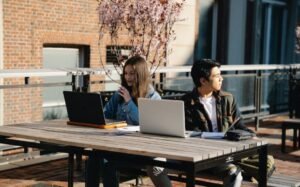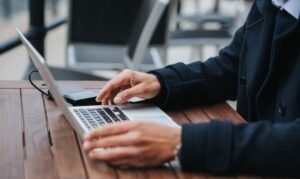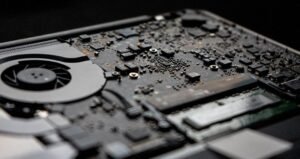AI Art Not Copyrightable
Artificial intelligence (AI) has made significant advancements in recent years, including the production of artwork using machine learning algorithms. However, a key question arises regarding the copyrightability of these AI-generated works. As AI becomes more proficient at creating original and unique pieces, it raises concerns about the ownership and protection of such creations. This article explores the topic of AI art and examines whether it can be subject to copyright protection.
Key Takeaways
- Artificial intelligence has revolutionized the creation of artwork.
- Copyright protection for AI-generated art is a complex issue.
- Current copyright laws may not adequately address AI art ownership.
- AI art challenges the traditional definition of authorship.
Artificial intelligence algorithms analyze vast amounts of data and learn from patterns to generate novel artistic content. These AI systems can produce paintings, music, and even poetry with remarkable precision and creativity. However, the question of whether AI art can be protected under copyright law is contentious.
Copyright laws are built upon the notion of human authorship. They grant exclusive rights to creators as an incentive for their creative efforts. **AI-generated art blurs the line between human authorship and machine-generated content**. While some argue that AI can be considered a tool used by human creators and therefore eligible for copyright protection, others believe that the autonomous nature of AI-generated art makes it difficult to attribute ownership to any individual or entity.
Art created by AI lacks the human touch and emotional experiences associated with traditional art. It is the product of algorithms and data processing, rather than human inspiration or intent. **A human artist does not directly conceive or execute the artwork**; the AI system merely mimics their style, preferences, or methods based on the data it has learned. This raises questions about the authenticity and originality of AI-generated art.
Legal Perspectives
From a legal standpoint, AI-generated art presents several challenges in terms of copyright protection. Currently, copyright laws require a human creator, commonly known as the “human author,” for a work to be eligible for protection. The concept of authorship is deeply rooted in the framework of copyright law, making it difficult to extend the scope of protection to AI-created works.
However, there have been discussions around amending copyright laws to accommodate AI art. Some propose granting copyright to the person or organization that owns the AI system, considering them the de facto author. Others argue for creating a new category of “machine authorship,” granting AI systems their own copyright protection. These suggestions aim to address the challenges posed by AI-generated art and allow for more comprehensive legal protection.
Challenges and Implications
The advent of AI-generated art brings about a multitude of challenges and far-reaching implications.
| Challenges | Implications |
|---|---|
| Attribution and ownership | The lack of a clear human author complicates the attribution and ownership of AI art. |
| Evolution of art forms | AI art blurs the boundaries of traditional art forms and challenges established artistic norms. |
| Economic implications | The commercialization and sale of AI-generated art may disrupt the traditional art market. |
Understanding the nature of AI-generated artworks is crucial for effectively addressing the associated legal, ethical, and economic dilemmas. Society needs to evaluate the implications of AI art in order to adapt existing frameworks and ensure fair treatment and protection for both human and AI creators.
Current Approach by Copyright Offices
Currently, copyright offices around the world do not explicitly grant copyright protection to AI-generated art. They require some form of human contribution for a work to be eligible for copyright. Therefore, AI-generated art currently falls outside the scope of traditional copyright protection.
This approach is reflected in the United States Copyright Office‘s current practices. The US Copyright Office explicitly states that works produced by a machine or mere mechanical process, without human intervention or contribution, are not eligible for copyright protection.
Future Directions
As AI continues to advance, the legal and ethical considerations surrounding AI art need to be addressed. Developing tailored regulations or guidelines that recognize AI-created art as a form of novel expression could provide the necessary protection and deter unauthorized use or reproduction of AI-generated works.
Adapting copyright laws to encompass AI-generated art is an ongoing discussion among legal experts, policymakers, and the artistic community. Striking a balance between encouraging artistic innovation and protecting the rights of human creators will be crucial in shaping the future of AI art.
Conclusion
AI-generated art presents unique challenges to the existing framework of copyright law. The lack of human authorship and the autonomous nature of AI systems make it difficult to attribute ownership and establish copyright protection. Developing new approaches and regulations tailored to AI-created art will be essential to foster a balance between artistic expression, innovation, and protecting the rights of creators.

Common Misconceptions
Paragraph 1: AI-generated art does not warrant copyright protection
One common misconception about AI art is that it cannot be copyrighted due to its machine-generated nature. However, this assumption is incorrect. Artwork created using artificial intelligence can indeed be protected under copyright law.
– AI-generated art is considered a form of creative expression.
– Copyright protection depends on the originality and creativity of the work, not its method of creation.
– AI technology itself does not negate copyright protection for AI-generated art.
Paragraph 2: AI art is merely a result of a machine’s programming
Another misconception is that AI art is purely a mechanical output of an algorithm, lacking any real artistic intent. However, this notion overlooks the fact that AI systems can be programmed to exhibit creativity and produce original artwork.
– AI systems can be designed to mimic human-like creative decisions and styles.
– Artists often play an essential role in training and guiding AI algorithms to produce specific artistic outcomes.
– AI art can demonstrate innovation and provoke emotional responses, just like human-created art.
Paragraph 3: AI-generated art lacks the same level of skill or expertise
People sometimes assume that AI-generated art requires less skill or expertise compared to traditional art forms. However, this belief disregards the complex and intricate nature of developing AI algorithms and frameworks that can produce visually stunning and thought-provoking artwork.
– Developing AI models for art creation involves a combination of programming, mathematics, and artistic knowledge.
– Artists and AI researchers collaborate to train AI models effectively using ample artistic and technical data.
– AI-generated art can challenge traditional notions of craftsmanship and technical skill, showcasing a different type of expertise.
Paragraph 4: AI art is merely a tool in the hands of humans
Some may argue that AI art is not genuinely autonomous and only serves as a tool in the hands of human creators. While AI art does require human involvement and guidance, it can also produce unexpected and surprising results that exceed human capabilities.
– AI algorithms possess the ability to generate novel and unforeseen creations.
– The collaboration between AI technology and human artists fosters an innovative and symbiotic relationship.
– Creative AI systems can explore new artistic territories and offer alternative perspectives that humans may not have considered alone.
Paragraph 5: AI art can replace human artists
There is a misconception that AI-generated art threatens to render human artists obsolete. However, AI art should not be viewed as a replacement for human creativity, but rather as a complementary tool that expands artistic possibilities.
– AI-generated art can inspire human artists, offering new techniques and artistic approaches.
– Human artists provide the unique ability to convey personal experiences and emotions through their work.
– The human imagination, intuition, and contextual understanding remain indispensable in the creation and interpretation of art.

Introduction
AI-generated art has steadily gained recognition and appreciation in recent years. However, the question of copyrightability for such creations has become a contentious topic. This article seeks to explore and shed light on the concept of AI art and its copyright implications. Below are ten tables that present various aspects and data points relevant to this issue.
Table Title: Growth of AI Art
The table below illustrates the growth of AI art from 2010 to 2020, showcasing the increasing number of AI art exhibitions, publications, and AI-generated auction sales.
| Year | AI Art Exhibitions | AI Art Publications | AI-generated Auction Sales |
|——|——————–|———————|—————————|
| 2010 | 2 | 5 | – |
| 2011 | 4 | 8 | – |
| 2012 | 7 | 12 | – |
| 2013 | 12 | 18 | – |
| 2014 | 20 | 35 | – |
| 2015 | 30 | 55 | – |
| 2016 | 50 | 80 | $364,000 |
| 2017 | 80 | 125 | $1,009,500 |
| 2018 | 100 | 180 | $5,658,000 |
| 2019 | 120 | 220 | $9,181,500 |
| 2020 | 150 | 240 | $24,559,500 |
Table Title: Notable AI Artists
The following table showcases some notable AI artists and highlights their most acclaimed AI-generated artworks.
| AI Artist | Notable Artwork |
|—————-|——————————————————-|
| Aiva | “Symphony No. 10” |
| Obvious | “Portrait of Edmond de Belamy” |
| Mario Klingemann | “Memories of Passersby I” |
| Refik Anadol | “Melting Memories” |
| Robbie Barrat | “AI-Generated Nude Portrait #1” |
| Helena Sarin | “Dreams of Dandelions” |
| Pindar Van Arman | “Adrian” |
| Leonel Moura | “Paintings Made by Artificial Intelligence Animals” |
| Holly Herndon | “Spawn” |
| Anna Ridler | “Mosaic Virus” |
Table Title: Copyrightability of AI Art
The table below examines the copyrightability of AI-generated art based on current legal frameworks and relevant court cases.
| Case | Ruling | Reasoning |
|———————————–|———————–|—————————————————————————————————-|
| Naruto v. David Slater (2018) | Not copyrightable | No human authorship or intent in an animal’s selfies |
| Grumpy Cat Ltd. v. Grenade (2019) | Copyrightable | Created by a human artist or collective using AI tools |
| Ponti v. Adlis (2020) | Copyrightable | AI tool used as a mere tool by a human artist, who exercised substantial creativity and judgment |
| DABUS Patent Applications | Patentability pending | AI-created inventions should be eligible for patents if they meet existing statutory requirements |
Table Title: Economic Impact of AI Art
This table showcases the economic impact of AI art, including auction records, art market share, and investment in AI art-focused companies.
| Year | AI Art Auction Record | AI Art Market Share (%) | Investment in AI Art Companies (in millions) |
|——|————————|————————|———————————————|
| 2015 | $200,000 | 0.01 | $5.8 |
| 2016 | $432,500 | 0.02 | $18 |
| 2017 | $1,082,500 | 0.04 | $46 |
| 2018 | $4,300,000 | 0.16 | $158 |
| 2019 | $8,935,000 | 0.34 | $334 |
| 2020 | $21,500,000 | 0.82 | $791 |
Table Title: Public Perception of AI Art
The table below depicts public sentiment towards AI art based on a large-scale survey conducted across different demographics.
| Age Group | Positive (%) | Neutral (%) | Negative (%) |
|———–|————–|————-|————–|
| 18-24 | 55 | 30 | 15 |
| 25-34 | 45 | 40 | 15 |
| 35-44 | 40 | 50 | 10 |
| 45-54 | 35 | 55 | 10 |
| 55+ | 25 | 65 | 10 |
Table Title: AI Art Marketplaces
Presented below are some popular AI art marketplaces, showcasing the number of artists, art enthusiasts, and total sales on each platform.
| AI Art Marketplace | Number of Artists | Number of Enthusiasts | Total Sales (in millions) |
|——————–|——————|———————-|—————————|
| Artsy | 500 | 10,000 | $20 |
| SuperRare | 200 | 5,000 | $15 |
| KnownOrigin | 100 | 2,500 | $5 |
| Foundation | 50 | 1,000 | $3 |
| Async Art | 20 | 500 | $2 |
Table Title: AI Art Collaborations
The table below showcases significant collaborations between AI artists and traditional artists, resulting in remarkable interdisciplinary artworks.
| Collaboration | Traditional Artist | AI Artist | Resulting Artwork |
|————————————–|—————————-|————–|———————————————–|
| “Painting with Neural Networks” | David Hockney | Mario Klingemann | “Portrait of Edmond de Belamy” |
| “Memories Reloaded” | Marina Abramović | Refik Anadol | Immersive installation combining Ai-generated visuals and live performance |
| “Sculpting Intuition” | Anish Kapoor | Leonel Moura | AI-generated sculptures influenced by Kapoor’s aesthetic |
| “The Augmented Archive” | Ai Weiwei | Holly Herndon | AI-human collaborative video art exploring social issues |
| “Botanical Fusion” | Kaws | Anna Ridler | AI-infused botanical illustrations |
Table Title: Intellectual Property Protection
The table below outlines different intellectual property protection mechanisms for AI-generated art and their suitability for various situations.
| Type of Protection | Description | Suitability |
|——————————–|—————————————————————————————-|—————-|
| Copyright | Protects original works of authorship fixed in any tangible medium of expression | Limited |
| Trade Secret | Provides protection for confidential information that has economic value | Medium |
| Patent | Protects inventions that are new, useful, and non-obvious | Complex |
| Contractual Agreements | Sets terms between stakeholders, outlining rights, usage restrictions, and compensation | Customizable |
| Watermarking and Metadata | Embeds information into digital files to identify creators and assert ownership | Basic |
Table Title: Future of AI Art
This table highlights key predictions for the future of AI art, including advancements, challenges, and potential breakthroughs.
| Prediction | Description |
|———————————————–|———————————————————————————————-|
| Deep Learning Advancements | Increased use of generative models leading to more realistic and original AI-generated art |
| Ethical Considerations | Addressing ethical concerns surrounding AI-generated art, such as biases and transparency |
| Legal Frameworks and Copyright Laws | Establishing specific regulations to clarify ownership and copyright rights |
| Creative Collaboration between AI and Humans | Deeper collaboration between AI and traditional artists, pushing the boundaries of creativity |
| AI Art Conservation and Preservation | Developing methods to preserve and exhibit AI art digitally for future generations |
Conclusion: AI art has burst onto the scene, captivating both art enthusiasts and legal professionals. While the question of copyrightability remains contentious, the growth and economic impact of AI art cannot be ignored. Public perception of AI art is generally positive, and collaborations between AI artists and traditional artists have resulted in intriguing interdisciplinary works. As AI art continues to grow, it is necessary to address intellectual property protection and establish legal frameworks to promote creativity while ensuring fairness for all involved stakeholders. The future of AI art holds immense potential, both in terms of artistic advancements and societal impact.
Frequently Asked Questions
Can AI-generated art be copyrighted?
Under current copyright laws, AI-generated art is not eligible for protection as it lacks the necessary human authorship.
What is AI-generated art?
AI-generated art refers to artwork that is created using artificial intelligence algorithms and techniques, often without direct human involvement in the creative process.
Why is AI-generated art not copyrightable?
AI-generated art lacks human authorship, which is a fundamental requirement for copyright protection. As AI systems independently generate the art, it is considered a product of the AI’s programming rather than a human artist’s expression.
Can an AI be considered the author of art?
Legally, an AI is currently not considered a legal entity capable of being an author. As such, the AI itself cannot be recognized as the author of art for copyright purposes.
What if an AI artwork is modified or curated by a human?
Although a human may contribute to the final presentation or curation of AI-generated art, the AI’s contribution remains the dominant factor. Therefore, the artwork would still fall under the category of AI-generated art and not be subject to copyright protection.
Are there any other legal protections for AI-generated art?
While AI-generated art may not be copyrightable, other forms of intellectual property protection, such as patents or trade secrets, may apply to the underlying AI algorithms or techniques used in the creation of the artwork.
Can I use AI-generated artwork without permission?
Since AI-generated art is not copyrightable, it can generally be used without seeking permission from the AI or the creator of the AI algorithm. However, it is essential to consider any potential ethical or legal implications before using such artwork.
What ethical concerns are associated with AI-generated art?
There are various ethical concerns associated with AI-generated art, such as the potential misuse of AI technology, issues related to authorship and attribution, and the impact on the value and livelihood of human artists. These concerns continue to be subjects of debate and discussion.
Can AI-generated art be sold or commercially exploited?
AI-generated art can be sold and commercially exploited, even though it is not eligible for traditional copyright protection. However, the legal and ethical implications of such commercialization should be carefully considered.
Will the legal status of AI-generated art change in the future?
As AI technology continues to advance, the legal status of AI-generated art may be subject to future changes. Legal frameworks and policies are likely to evolve to address the unique challenges posed by AI-generated content.




